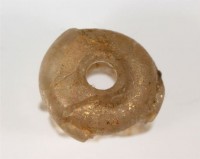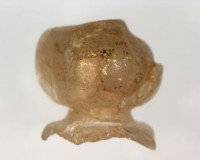For your Just Too Cool file comes this from the History Blog:
Roman jewelry found in ancient Japanese tomb
Two glass beads that bear the characteristics of Roman craftsmanship have been found in a 5th century tomb in Nagaoka, near Kyoto in southern Japan.
The tiny five-millimeter (0.2 inch) beads date to between the 1st and the 4th century A.D. and were made with natron, a naturally occurring chemical that was widely used in ancient Egypt for everything from brushing teeth to mummification. The Romans added it to sand and lime to make ceramics and glass. The process fell out of use in the 7th century A.D. The beads, which have a hole through the middle, were made with a multilayering technique — a relatively sophisticated method in which craftsmen piled up layers of glass, often sandwiching gold leaf in between.
“They are one of the oldest multilayered glass products found in Japan, and very rare accessories that were believed to be made in the Roman Empire and sent to Japan,” said Tomomi Tamura, a researcher at the [Nara National Research Institute for Cultural Properties].
The “sent to Japan” part is questionable (a translation issue, perhaps?). There was no direct trade between Rome and Japan. As early as the 1st century A.D., the complex of trading networks on sea and land that are known today as the Silk Road ran from Europe through Africa, Arabia, Persia, India, China, and Korea to Japan and back again. Traders did local legs of the massive voyage, stopping at market cities to sell their goods which would then be traded again a little further away and so on, until silk from China wound up adorning Roman emperors and Roman gold-flecked glassware jewels ended up the prized possession of a 5th century Japanese nobleman.
[…]
I’ll bet they were put there by Casca Rufio Longinus.




































Ahhhhhhhhhh … a Barry Saddler fan, I see. I haven’t read the Casca series — are they a fun read? I met Barry Saddler waaaaayyyyy back in 1966 or so at Ft. Bragg (my father was Special Forces even before they wore berets, and then after) when I was in 6th or 7th grade. One of my classmates would baby-sit for the Saddlers; he said Barry had an extensive collection of WWII German medals and headgear … cool stuff!
Cheers,
–Guy
Heh, heh. Never read the Casca books, though.
There’s a Japanese guy who theorizes that some of the Chinese Nestorian Christians got converts in Japan. So the “to Japan” part may have been a contribution by the news guys who remember that theory, or maybe they just wanted to make it more sensational.
Fr. Z., as I first started to scroll through, I saw the objects, and for a second thought, oh dear God, what is he cooking now. :)
I am on the same page with Kathleen! I looked at the first piece of jewelery and thought is Fr. Z making a shade of bagel I have never seen before!
There is no reason why Roman artifacts would not get to Japan via the Silk Road. For over 2000 years, travel, caravans, trade went back and forth from the Far East to the Near East, and ergo, the Mediterranean countries of Europe. I am just surprised such jewelry has not been found before.
There is so much we do not know about the ancient world, but men and women were just as enterprising and intelligent as we are now, and, perhaps, more energetic. Very cool
http://upload.wikimedia.org/wikipedia/commons/thumb/e/ed/Transasia_trade_routes_1stC_CE_gr2.png/800px-Transasia_trade_routes_1stC_CE_gr2.png
Cool map here includes Japan in the Silk Road routes…
Echoing Kathleen10, when I was scrolling, I thought I saw doughnuts :-)
this is important because it shows how human interaction is intertwined in ways we don’t anticipate. This was almost certainly not ‘sent’ to Japan, but someone in Japan placed a value on it. I think good acts of faith, hope, charity, and contrition are performed they can have an impact far away and in another time we do not anticipate.
Now that is Very Cool! Will share this with my daughter during our homeschooling today! Thanks!
Awesome!! Very significant.
Awesome Very significant.
Pingback: MONDAY AFTERNOON EDITION | Big Pulpit
This IS very cool. As of late, I have become interested in, and have been watching several historical Korean dramas online. The first one I watched (yes, one must read the subtitles as well) is in regard to a 7th century queen of the kingdom of Silla (this was during the Three Kingdoms period of Korea), Queen Seondeok. During the early episodes, there was a group of traders who traded regularly with Arabian, Persian, and Roman merchants, and had learned to speak Latin. Some of the merchants had taught the young princess to also speak Latin, although there was no indication of her having actually met any Romans.
“Silk Road” …. ahhhhhhh — that reminds me of Kitaro’s suite of the same name. It was very popular years ago and incorporated into an NHK documentary about the silk road.
Kitaro: http://www.youtube.com/watch?v=mw86dS5AdD8
–Guy
Fascinating! Did some enterprising trader make it all the way to Japan (not impossible, presumably: but less probable?)? If not, how many fascinating transactions may have taken place en route: who parting with what in exchange for these, and with these in exchange for what?